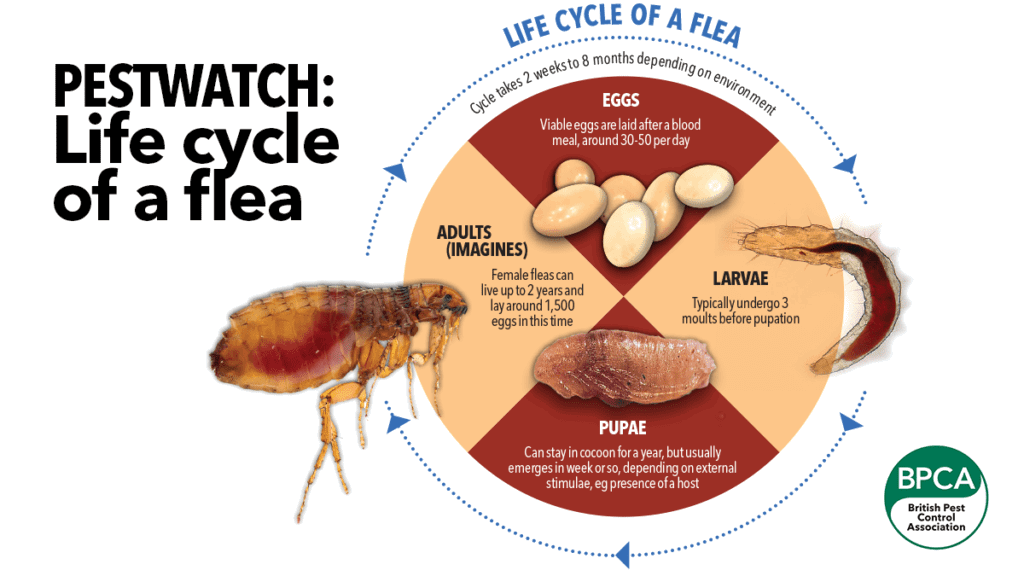Fleas are a parasite that feed off the blood of their host. Their bites are very itchy and can cause severe irritation in large numbers. A flea infestation can be a pesky problem, read on to find out how to prevent an infestation and treat an infestation.
Signs your pet may have fleas
There are a few different signs that may be seen that may indicate your pet has fleas, these include:
- A pet that is scratching, licking or biting at themselves
- Spotty or scabby skin
- Areas of hair loss or sore patches of skin
- Dark specks in the fur
- Small brown-black insects moving about in the fur
- Unaccounted for insect bites on you or other family members
How to check your pet for fleas
There is an easy way to check for fleas. Comb your pet with a fine tooth comb over a white surface (such as kitchen roll). This will cause any fleas or droppings to fall onto the white surface. To check if the dark specks are flea droppings add a few drops of water. Flea droppings will become a reddish brown and will leave red marks on the white surface. If you are still unsure book an appointment with us so that we can check for you.
How can you prevent flea infestations?
Flea infestations can be difficult to get rid of. It is best to prevent them by using a good quality veterinary licenced flea product at regular intervals (usually monthly). Some of the flea products which can be brought from pet stores, or in supermarkets, are older products which may be ineffective or may repel the fleas rather than killing them. Please make sure any product you use has been designed for the animal you are using it on. Some dog flea products (those containing permethrin) can be toxic to cats.
Fleas can spread tapeworm and so prevention of fleas will reduce the likelihood of your pet getting tapeworms. If your pet gets fleas then it is advisable to treat for tapeworm too. Flea prevention is important in rabbits as well, because fleas are known to spread myxomatosis.
Where do fleas come from?
Around 95% of the flea population live in the environment and not on your pets. In some cases flea eggs can survive dormant for up to 18 months, so it is possible your home was infested before you moved in. Pets can pick up fleas from other animals or places and bring them home. Humans can also pick them up on their clothes or in their hair and bring them home. A flea is not picky and does not need a dirty home to infest.
What do I do if my pet has fleas?
If your pet has fleas then you will need to treat them, and any other pets in the house. We advise using a veterinary licenced flea treatment that you can buy from us. Around 95% of the flea population actually live in the environment (for instance your house), rather than on your pet. That means that you also need to treat your house and anywhere else your pet spends time, such as the garage or car. We recommend a household flea spray which also has the insect growth regulator S-methoprene in it.
What to do when your flea treatment “is not working”
The flea lifecycle comprises of four stages: eggs, larvae, pupae and the adult flea. By treating your pet you will kill any adult fleas that bite your pet. By treating the environment with a house spray you will kill the larvae and any eggs. However no treatment is effective against the Pupae stage. This means that adult fleas can still hatch out and bite your pet after you have treated them and the house. Therefore despite treatment sometimes you will still see adult fleas for a while, sometimes up to three months. The good news is when these adult fleas bite your pet the flea treatment will kill them before they can lay more eggs.
There are certainly a few things that you can do to make sure that your treatment works well:
- Treat your pets for at least three months whilst the infestation clears. Ideally you would continue long-term to prevent re-infestation.
- If you have treated using a spot on make sure that your pet does not get wet within 48 hours before or after application to make sure that product efficacy is not reduced.
- When using a household spray make sure to treat everywhere your pet goes, including the garage, shed and car. It also helps to spray the hoover chamber as well.
- Before using the household spray we advise hoovering the house first. Fleas hatch from the pupae stage into adult fleas with stimulation from vibration and warmth. As most hoovers do this you will increase the percentage of the flea population that you can treat.
- Wash any bedding on regularly at 60 degrees.
- When hoovering and treating the house, wooden floors are just as important as carpets. Don’t forget to hoover furniture, under furniture and along any skirting. Fleas often pupate in dark grooves near to where your pets spend most of their time.
- Empty the vacuum after each use to prevent the eggs and larvae developing into fleas.
A word of warning.
The household flea sprays are toxic to cats, fish and reptiles. When treating your house you will need to cover any fish tanks and reptiles. For cats treat the house whilst they are out and ventilate for an hour before they are allowed back in. With indoor only cats shut them in one room whilst you treat the rest of the house, and then treat that room later.
For more information on flea infestations click here.



